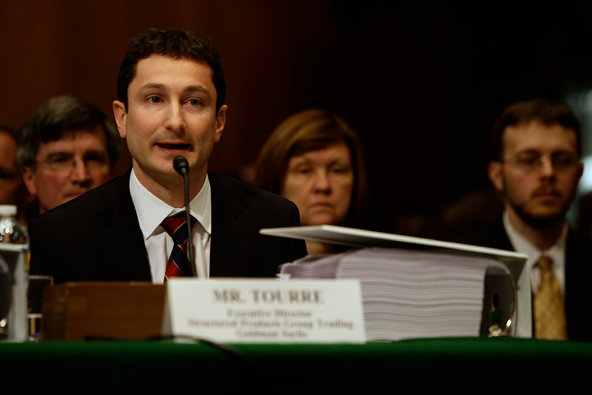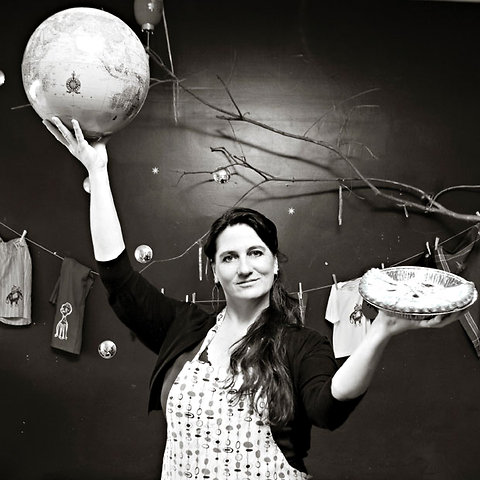 Doug Mills/The New York TimesFabrice Tourre testified before a Senate panel in 2010. The subcommittee was investigating investment banks.
Doug Mills/The New York TimesFabrice Tourre testified before a Senate panel in 2010. The subcommittee was investigating investment banks.
Next Monday, in a courtroom in downtown Manhattan, the Securities and Exchange Commission will begin what is likely to be its most prominent case stemming from the financial crisis: its case against Fabrice Tourre, a former Goldman Sachs trader who is accused of misleading clients by selling a mortgage securities investment that the government said was designed to fail.
Mr. Tourre, as you might remember, was a 28-year-old French banker who wrote this gem of an e-mail to his girlfriend in 2007, which was widely quoted several years ago: “The whole building is about to collapse anytime now,” he explained to her about the markets. “Only potential survivor, the fabulous Fab,” he continued, not so humbly referring to himself, “standing in the middle of all these complex, highly leveraged, exotic trades he created without necessarily understanding all of the implications.”
DealBook Column
View all posts
Related Links
Goldman Sachs paid $550 million to settle the case in 2010 without admitting or denying guilt. Mr. Tourre, however, turned down an offer to settle. He wanted his day in court. And now that day has come. The trial is seen within the S.E.C. and on Wall Street as a referendum on Goldman Sachs and the government’s case, which was never argued in front of a jury.
But the jury may never hear the full account if the S.E.C. gets its way.
The heart of the S.E.C.’s case contends that Mr. Tourre and Goldman created a mortgage security known as Abacus with the help of the hedge fund run by the billionaire John A. Paulson. Mr. Paulson’s firm helped choose the assets in that security and then bet against it. The S.E.C. contends Mr. Tourre deliberately hid the intentions of the Paulson fund so that Goldman could more easily sell Abacus to investors who would unknowingly bet that its value would go up, including ACA Management, which both invested in Abacus and helped approve its components.
The entire case rests on whether Mr. Tourre deprived investors of information that the S.E.C. says they needed to make an informed investment decision.
And so it is a little awkward, in a case that hinges on appropriate disclosure, that the S.E.C., in a bevy of pretrial briefs, appears to be fighting vociferously to exclude troves of evidence from the trial that the defense says is material for the jury to make an informed decision about Mr. Toure’s innocence or guilt.
The S.E.C., for example, has sought to block any mention of news reports that Mr. Paulson was betting against the subprime mortgage market. The defense argues that the news reports are necessary to demonstrate that the institutional investors, who arguably read the news as part of their jobs, were not duped into thinking that Mr. Paulson was betting that the value of Abacus would rise, undercutting the S.E.C.’s contention that the investors were misled victims.
“News articles about Paulson’s purported macro investment strategy of shorting the subprime housing market are not relevant,” the S.E.C. wrote. “Such articles are irrelevant, prejudicial and confusing. With respect to most or all of them, there is no evidence that they were read by the employees of ACA Management.”
The S.E.C. has also tried to block references to public statements made by current and former regulators, including Ben S. Bernanke, Henry M. Paulson Jr. and Alan Greenspan, that suggested that the subprime lending problems were overblown. That would buttress the defense’s case that investors made the decision to invest in Abacus, and bet it would go up in value, based on their research and a prevailing view in the marketplace. “What government regulators believed about the subprime housing market in 2007 has nothing to do with the facts of consequence to the determination of this action,” the government wrote the court.
What else might the jury miss?
One of the biggest issues is this: ACA, which the S.E.C. has portrayed as a victim of Mr. Tourre’s fraud, was not considered a victim when the government divided the $550 million Goldman Sachs settlement that had been set up to repay victims. The government excluded ACA completely from the list of investors that were paid from the Goldman settlement. How can ACA be a victim for the purpose of Mr. Tourre’s case, but not be for the purpose of the recompense? The S.E.C. says the victim list from the fund is irrelevant. Payments are “entirely discretionary and involve policy judgments that do not necessarily reflect any decision about whether a particular entity or institution was actually victimized as a result of a defendant’s fraud,” the S.E.C. said in a legal brief. (If the S.E.C. is being honest about how it determines who is a victim, it raises a hornet’s nest of policy questions that are worth investigating.)
Then there is the issue of who else has been charged in the case — or rather, has not been charged. The government has argued that Mr. Tourre is part of a “scheme” to defraud investors, but the government has not charged anyone else. The S.E.C. insists that jurors not be told that.
Next is Lucas Westreich and his honeymoon. Mr. Westreich, a former employee of ACA who appears on a recorded phone call that prosecutors say is central to their case, has told the court that he will be unavailable to testify in person because he will be on his honeymoon outside the country. The government seems perfectly fine with Mr. Westreich’s skipping out on the case, saying that he is expected to claim he does not remember the call.
The defense has suggested that it wants to cross-examine him about other tape recordings that it says may undermine the claims made on the original call. The government has consented to Mr. Westreich being deposed on videotape. The defense, which subpoenaed him in December 2012, wants him to appear live.
It is unclear whether he will appear, but the judge hinted: “Somebody just sitting there on this highly relevant call saying ‘I don’t recall a thing about it,’ even if it is 10 minutes, is potentially useful for the jury to see, because they can see whether or not this guy looks like a guy who just doesn’t recall or a guy who is squirming around and doesn’t recall. Sometimes people squirm.”
Finally, there is the S.E.C.’s star witness, Laura Schwartz, a former ACA employee who is expected to testify that she was duped by Mr. Tourre into thinking that Mr. Paulson’s firm was investing in Abacus side by side with her. For the last several months, there had been a fierce battle between the government and the defense over whether the jury should hear that the S.E.C. had issued a Wells notice to her on an unrelated matter, indicating that the government was considering bringing a case against her.
The defense had argued in pretrial briefs that jurors needed to know about the Wells notice to measure her motive to testify on behalf of the government. But just last week, the S.E.C. ended its case against her, effectively trying to take the issue off the table ahead of the trial. Late Tuesday, however, the defense submitted a brief to the court saying that it believed jurors needed to know about the inquiry into Ms. Schwartz.
“Even if one were to accept that there was no quid pro quo here (and the court should not), the bias materials remain relevant to and necessary to fair cross-examination, for example, as to whether Ms. Schwartz cited her cooperation with the S.E.C. in this case as a basis on which it should not bring charges against her,” the brief said.
We will see next week how much the jury ultimately finds out.
Article source: http://dealbook.nytimes.com/2013/07/08/traders-day-in-court-may-lack-some-details/?partner=rss&emc=rss


